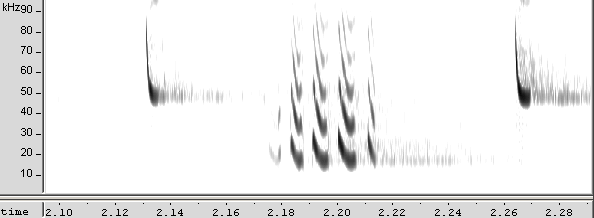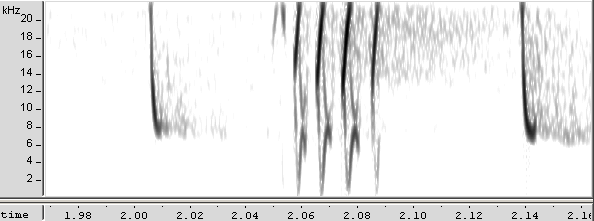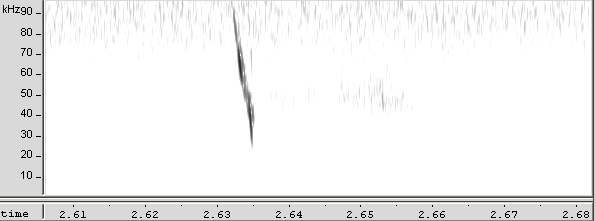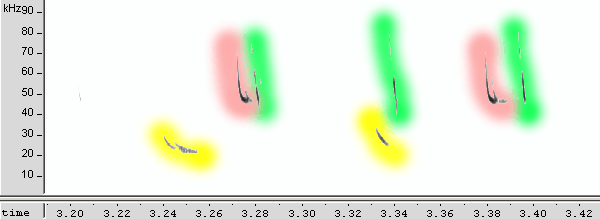Recordings of ultrasonic vocalisations of bats
The pipistrelle, Britain's smallest and most common species, emits calls between about 70kHz and 20kHz. Its echolocation call is a frequency-modulated downsweep from about 70kHz to 45kHz with a characteristic dwell on the lowest frequency at the end, giving the spectrogram a backwards-J shape (leftmost and rightmost call in the spectrogram below). Echolocation calls are reasonably pure tones, and contrast with the lower and harmonically rich social call in the middle of this spectrogram, which is not used for ranging but communication with other bats.

Direct spectrogram of the high-frequency bat call.
When slowed down 10x, this call sounds like this.
The spectrogram is detail of the area around 22 seconds in - the social call is clearly different in character from the echolocation calls.
If this signal is passed through a bat detector set to 40kHz, the resulting spectrogram takes on this form

The bat detector zooms in to the range 40-60kHz for the echolocation calls. Unfortunately, because nearly all heterodyne bat detecors are direct conversion, they alias the frequencies 20-40 kHz into the same frequency range, and this can be seen in the distorted structure of the social call
You can hear what this sounds like in this clip. The rasp in the middle is the social call.
Recording made Rushmere, Suffolk, UK 21 April 2007
Feeding buzz
As the bat approaches its target it needs to update its position information more frequently. It shortens the interval between echolocation pulses, and the amplitude of these is reduced.
Pipistrelle feeding buzz time-expanded. Heard in a bat detector this drop in pulse repetition frequency gives a characteristic 'buzz' as it homes in to its prey.
Below you can listen to what this sounds like through a bat detector.
Recording made Kingcombe, Dorset, UK, 20 May 2007
Differentiating species
The pipistrelle echolocation call has a characteristic backwards-j shape, as the frequency downsweeps slows towards the low frequency end and there is a short dwell at the lowest frequency. This gives the call a characteristic tone colour that many people describe as a 'wet slap' which you could hear in the above recordings

Britain has 17 species of bat, and the echolocation calls vary. For instance this Natterer has a more linear downsweep over a wider frequency range than the pipistrelles, without the dwell at the end
In this time-expanded clip you first hear the Natterer, followed in the second half by a pipistrelle. showing nicely the difference in tone colour. Heard in a bat detector there is still a difference in sound.
Recording made Kingcombe, Dorset, UK, 20 May 2007

Three bat species feature in this recording from Hungary - noctules highlighted yellow, pipistrelles in pink and natterer's in green. You can hear the different species calls in this time-expanded recording.
Recording made Szilvas-volgy, Hungary, 12 May 2007
A useful resource for bat recordists is the University of Bristol's Bat pages
Recording in the ultrasonic range.
Although the ultrasonic spectrum is refreshingly free of many of the noises that dog recordists such as traffic rumble, aircraft noise and wind noise it comes with challenges of its own. Tyre noise still extends into the ultrasonic range, as does the rustling of leaves in the trees and reeds in reedbeds. One of the reasons the ultrasonic spectrum is free of too much noise is that high frequencies do not carry well and are easily blocked by obstructions - this has the corollary that you have to be reasonably close to your subject.
Ultrasonic microphones tend to be quite directional, as the wavelength of the sound becomes of the same order or smaller than the microphone diaphragm - the wavelength at 30kHz is about 1cm. The directional pattern is like a hypercardioid/shotgun microphone, with a main lobe width of 10-20 degrees. It is possible to make stereo recordings using these, in a similar way to using angled shotgun microphones. Time expansion destroys the stereo effect, however - it is only preserved if you take a heterodyne recording.
Heterodyne recording of three pipistrelles feeding
Recording made Kingcombe, Dorset, UK, 20 May 2007
Time expansion of the original signal for the above - although this is two channel I hear no stereo effect at all.
Recording sounds you cannot hear is challenging - although it is possible to connect a bat detector downstream of the tape output the local oscillator of the bat detector tends to find its way into the input producing spurious tones. I therefore used the bat detector to establish the presence of bats and then turned it off - with experience you can recognise the presence of bats by a characteristic pulsing on the LED record indicators. Bat vocalisations have a remarkably high peak to mean ratio and it takes time to learn to record these without overmodulation.
The absence of environmental noise in this frequency range and the large gaps between pulses means that noise is very apparent , and ultrasonic microphones are less sensitive than normal (-42dB ref 1Pa for the type used here compared with -26dB ref 1Pa for a ME66). Because bats are nocturnal you cannot see them to aim the mic, though with some experience you can aim the mic down likely flight paths as bats tend to follow linear features, increasing the amount of time the bats spend in the microphone's sensitive area. Nevertheless, bat recording is still a bit of a fishing experience - accurate aim of the 10-20 degree mic peak sensitivity is not possible and the erratic flight pattern of bats would make them hard to track even if you could see them well enough.
Other subjects
Bats are the most well-known mammals that vocalise in the ultrasonic region, and their signals are quite loud, which is convenient given the relative insensitivity of ultrasonic microphones. However, other small mammals emit vocalisations in this frequency range, and some insects too - there is a whole range of grasshoppers and crickets to explore.